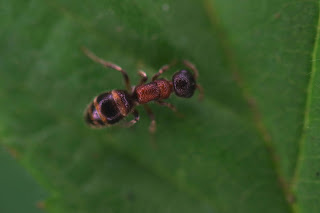When I first started my backyard bug project there were very few bugs I could identify. There were entire orders of insects that I had never heard of, never seen a single member of, and had a hard time even looking up in my bug books (when I finally got books), because they were so alien to me that I didn't know where to look. I've learned a lot since then, and much of the time even if I have never seen a bug before, and don't know what it is, I can at least figure out from certain features what order they belong to, and where to find them in a field guide. I can see a Hemiptera and know it's a Hemiptera. But sometimes I still am confused about the things that I find, and not even necessarily because I have found something from a smaller order that I have never found bugs from before. Sometimes it's just really hard to know what I am looking at.
And that brings us to the Backyard Bug of the Day:
I think this is an ant. But I am not completely sure. I thought it might actually be a velvet ant, which is not an ant, but a kind of wasp with wingless females. It looks like an ant. Mostly. But sort of not. I did try looking it up as both an ant and a velvet ant, but did not find it. Complicating matters of identification for me is the fact that ants and wasps belong to the same order, Hymenoptera. That's pretty interesting in itself, that ants and wasps are closely enough related as to belong in the same order. If you really look at them you can see how it makes sense that they are related. But also not really. Hymenoptera is a confusing order. I still cannot reliably tell the difference between a bee and a wasp sometimes, and then you throw in the sawflies, which as wasps, not flies, while there are a lot of flies that look a great deal like they are wasps or bees...
It is about the size of a medium-sized ant. It's probably an ant. But I am not sure. Anyway, in trying to find out I learned that there are species of ants called Dracula Ant and Odorous Ant, so even if I did not find out what I wanted to know, the name of this insect, it was not time wasted. I would also like to mention that as little as I know about ants, I know enough to know how shocking it is that one of my field guides, which is about insects of New England, has only a few species of ants in it, when I have seen quite a number of ant species in my backyard. I always expect the books to have more species than my backyard.
Other Bugs:
Arachnid Appreciation:












No comments:
Post a Comment